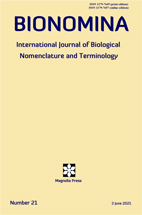Abstract
Wallach (2020a: 10) erected a new genus Virgotyphlops for the typhlopid snake species Eryx braminus Daudin, 1803, which had previously been referred by Hedges et al. (2014) to their genus Indotyphlops. Unfortunately, this new generic nomen is nomenclaturally unavailable, and should therefore not be used as valid as long as it has not been properly published.
References
Repfocus (2021) <http://www.repfocus.dk/Virgotyphlops.html> [Accessed on 15 January and 5 February 2021].
Reptile Database (2021) <https://reptile-database.reptarium.cz/species?genus=indotyphlops&species=braminus>. [Accessed on 15 January and 5 February 2021].
Wikipedia (2021) <https://en.wikipedia.org/wiki/Indotyphlops_braminus> [Accessed on 15 January and 5 February 2021].
Scientific publications
Anonymous [International Commission on Zoological Nomenclature] (1999) International code of zoological nomenclature. ‘Fourth edition’. London (International Trust for zoological Nomenclature): i–xxix + 1–306.
Anonymous [International Commission on Zoological Nomenclature] (2012) Amendment of Articles 8, 9, 10, 21 and 78 of the International Code of Zoological Nomenclature to expand and refine methods of publication. Bulletin of zoological Nomenclature, 69 (3): 161–169. <https://doi.org/10.21805/bzn.v69i3.a8.161>.
Amiet, J.-L. (2012) Les rainettes du Cameroun (Amphibiens Anoures). Saint-Nazaire (La Nef des Livres): 1‒591.
Arribas, O. J. (2016) Why Caucasilacerta Harris, Arnold & Thomas, 1998 is a nomen nudum? Russian Journal of Herpetology, 23 (4): 305–306.
Daudin, F. M. (1803) Histoire naturelle générale et particulière des Reptiles. Paris (F. Dufart), 7: 1–436, pl. 81–112.
Dubois, A. (2017a) A few problems in the generic nomenclature of insects and amphibians, with recommendations for the publication of new generic nomina in zootaxonomy and comments on taxonomic and nomenclatural databases and websites. Zootaxa, 4237 (1): 1–16. <https://doi.org/10.11646/zootaxa.4237.1.1>.
Dubois, A. (2017b) The nomenclatural status of Hysaplesia, Hylaplesia, Dendrobates and related nomina (Amphibia, Anura), with general comments on zoological nomenclature and its governance, as well as on taxonomic databases and websites. Bionomina, 11: 1–48. <https://doi.org/10.11646/bionomina.11.1.1>.
Dubois, A., Crochet, P.-A., Dickinson, E. C., Nemésio, A., Aescht, E., Bauer, A. M., Blagoderov, V., Bour, R., Carvalho, M. R. de, Desutter-Grandcolas, L., Frétey, T., Jager, P., Koyamba, V., Lavilla, E. O., Loebl, I., Louchart, A., Malecot, V., Schatz, H. & Ohler, A. (2013) Nomenclatural and taxonomic problems related to the electronic publication of new nomina and nomenclatural acts in zoology, with brief comments on optical discs and on the situation in botany. Zootaxa, 3735 (1): 1–94. <https://doi.org/10.11646/zootaxa.3735.1.1>.
Dubois, A., Frétey, T. & Ohler, A. (2018) The Relictus case: it is high time that taxonomists follow the Code’s requirements for nomenclatural availability and validity of new zoological nomina. Bionomina, 13: 51–64. <https://doi.org/10.11646/bionomina.13.1.4>.
Dubois, A. & Ohler, A. (2018) The Hyla quoyi‒Hyla prasina case (Amphibia, Anura), with comments on bibliographic and taxonomic databases and on Article 23.9 of the Code. Zoosystema, 40 (23): 501‒506. <https://doi.org/10.5252/zoosystema2018v40a23>.
Dubois, A., Ohler, A. & Pyron, R. A. (2021) New concepts and methods for phylogenetic taxonomy and nomenclature in zoology, exemplified by a new ranked cladonomy of recent amphibians (Lissamphibia). Megataxa, 5: 1‒738. <https://doi.org/10.11646/megataxa.5.1.1>.
Dubois, A. & Raffaëlli, J. (2009) A new ergotaxonomy of the family Salamandridae Goldfuss, 1820 (Amphibia, Urodela). Alytes, 26 (1–4): 1–85.
Hedges, S. B., Marion, A. B., Lipp, K. M., Marin, J. & Vidal, N. (2014) A taxonomic framework for typhlopid snakes from the Caribbean and other regions (Reptilia, Squamata). Caribbean Herpetology, 49: 1–61. <https://doi.org/10.31611/ch.49>.
Sanchíz, B. (1984) Análisis filogenético de la tribu Alytini (Anura, Discoglossidae) mediante el estudio de su morfoestructura ósea. In: H. Hemmer & J. A. Alcover (ed.), Història biològica del ferreret, Mallorca (Moll): 61–108.
Wallach, V. (2020a) How to easily identify the flowerpot blindsnake, Indotyphlops braminus (Daudin, 1803), with proposal of a new genus (Serpentes: Typhlopidae). Pod@rcis, (n.s.), 11 (1): 4‒12.
Wallach, V. (2020b) First appearance of the Brahminy blindsnake, Virgotyphlops braminus (Daudin 1803) (Squamata: Typhlopidae), in North America, with reference to the states of Mexico and the USA. IRCF Reptiles & Amphibians, 27 (2): 326–330.


